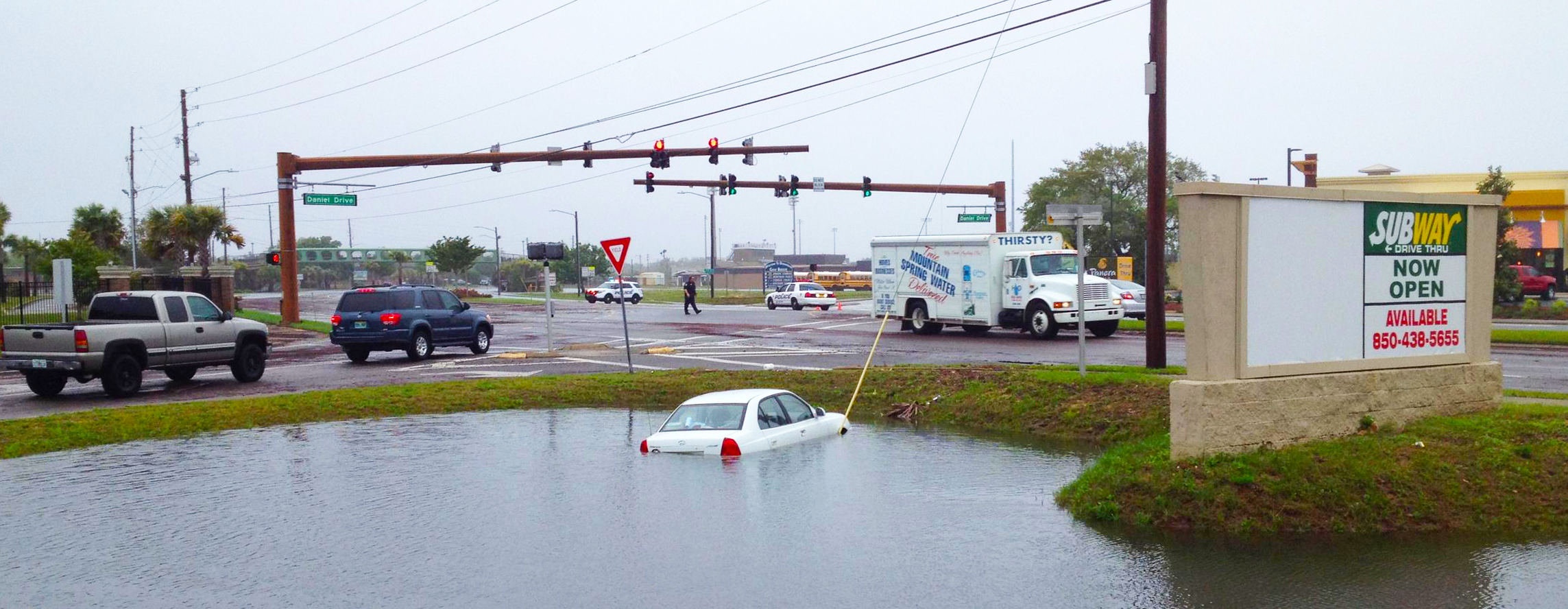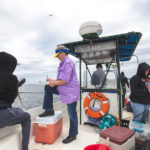UWF Researchers Help Conduct Study on Impact of Historic Flood
Pensacola – The historic flooding that struck the westernmost part of Florida in April 2014 inundated some areas of Pensacola with more than 15 inches of rain in a day and destroyed roads and bridges.

Until recently, however, the health and environmental impact of that devastating flood had not been studied. Dr. Jason Ortegren, an associate professor in the University of West Florida Department of Earth and Environmental Sciences, along with UWF graduate students Rebecca Foglietti and Talia Smith, are co-authors of a first-of-its-kind health impact assessment of the extreme flooding that took place in Escambia County from April 28 to May 3, 2014.
They collaborated on the report with the Florida Department of Health and the Florida Environmental Public Health Tracking program.
“The Florida Department of Health in Tallahassee had already secured a grant from the (U.S Centers for Disease Control) to conduct a health impact assessment somewhere in Florida,” said Ortegren, who is a climatologist and meteorologist. “And they thought that the April-May flood of 2014 served as a good example.”
The health impact assessment is the first done by the Florida Environmental Public Health Tracking, said Chris DuClos, the program’s manager.
“We chose UWF to collaborate with because they provided local expertise in pulling and interpreting the precipitation data for Escambia County,” DuClos said.
Ortegren said the UWF team’s work on the health impact assessment included a wealth of mapping and statistical analysis.
“We retrieved the majority, or all, of the environmental data, and that included things like the (Emerald Coast Utilities Authority) data, sewage lift station failures, road and bridge failures,” he said. “We coordinated and worked with the relevant county offices in each case to get whatever data we could to give basically the baseline environmental description against which the health analysts could interpret their results.”
To determine if there were increases in injury, illness, and death as a result of the flooding, data on “reportable diseases, hospitalizations, emergency department visits and deaths that occurred during the flooding event” were compared to a control period in 2008 where there was a normal amount of rainfall.

According to the report, the results of the comparison were “mixed, with some Escambia County ZIP codes showing increased hospitalizations and (emergency department) visits, and some ZIP codes showing a decrease.”
However, the report did reveal that, county-wide, there were increases in the proportion of both “injury and respiratory- related hospitalizations and (emergency department) visits” during the 2014 flooding period. There were 231 hospitalizations and 1,970 emergency department visits related to injury in Escambia County during the flood event. They accounted for 10.9 percent of all hospitalizations and 24.3 percent of all emergency department visits during the five-day period, the report showed.
The health impact assessment includes several policy recommendations, including that electric panels on sewage lift stations be raised above the flood elevation, in order to keep them operational during extreme rainfall events.
For the study, records for 357 lift stations were collected, showing that a total of 31 failed at some point during the five-day period.
Also recommended in the health impact assessment is that environmental sampling be conducted wherever feasible to understand how flood waters are impacting surface and ground water.
“The hopes are first, that some of the findings here actually help reduce health impacts if a similar event occurs in the future in Escambia County, or elsewhere,” Ortegren said. “Second, we hope that we have moved the (health impact assessment) experiment forward. We’ve done a little part in providing an example.”
The final goal, Ortegren, said, is to get the results of the study published.
DuClos said the report will be posted on the Florida Environmental Public Health Tracking website and shared with other agencies including the ECUA and Escambia County government, as well as other county health departments.
Ortegren said working on the report was especially beneficial to the two graduate students who not only got the chance to be co-authors on a government report, but also were able to collaborate with people from different disciplines. Another benefit was the new connections Ortegren and the students made with officials with the Department of Health.
“It just fell into my lap,” Ortgren said of the collaboration. “It was one of the rare instances in which they needed somebody who could do what we do, and they found us.”



